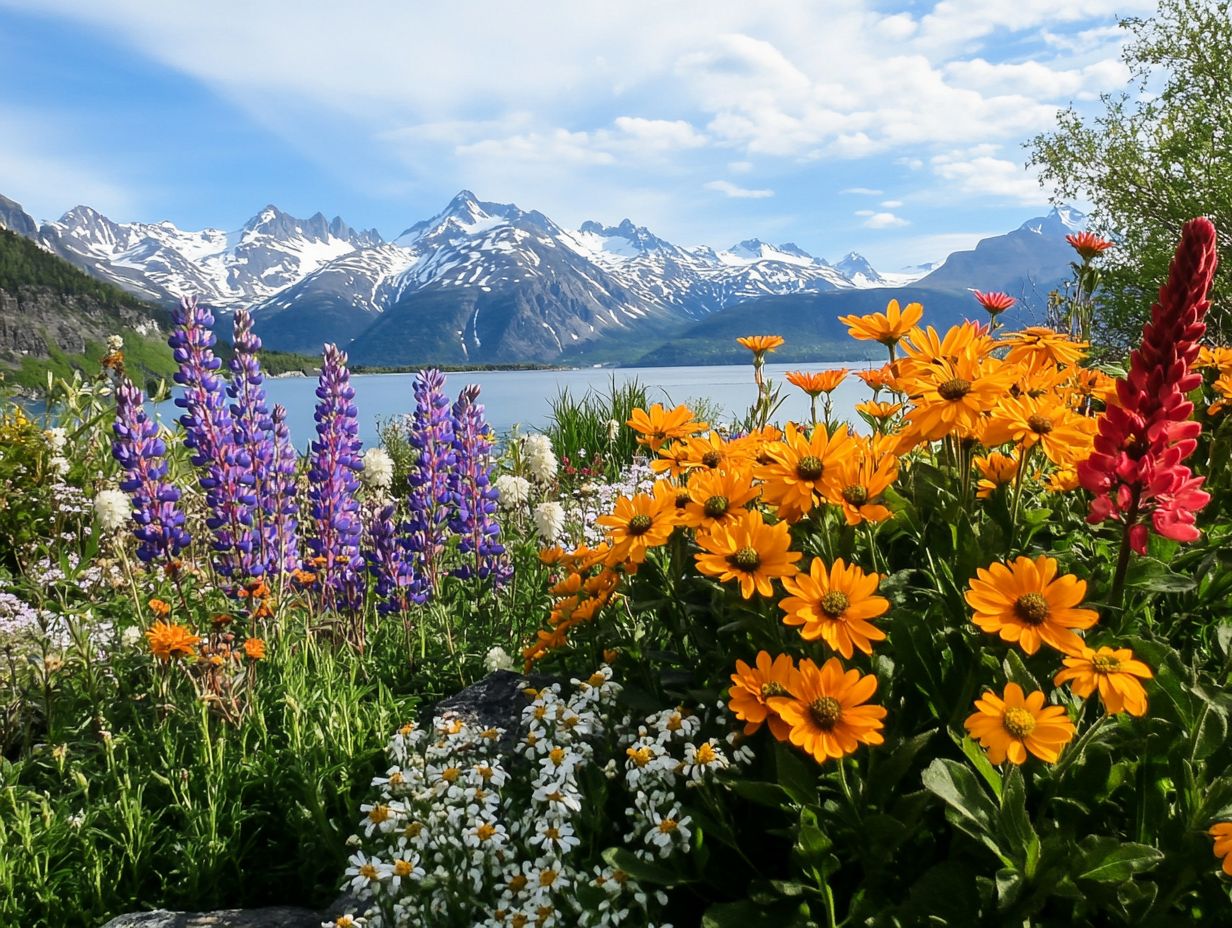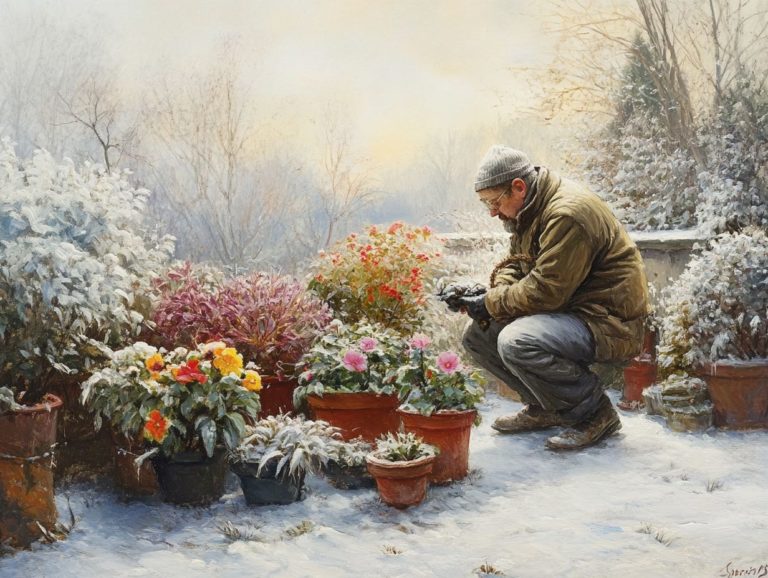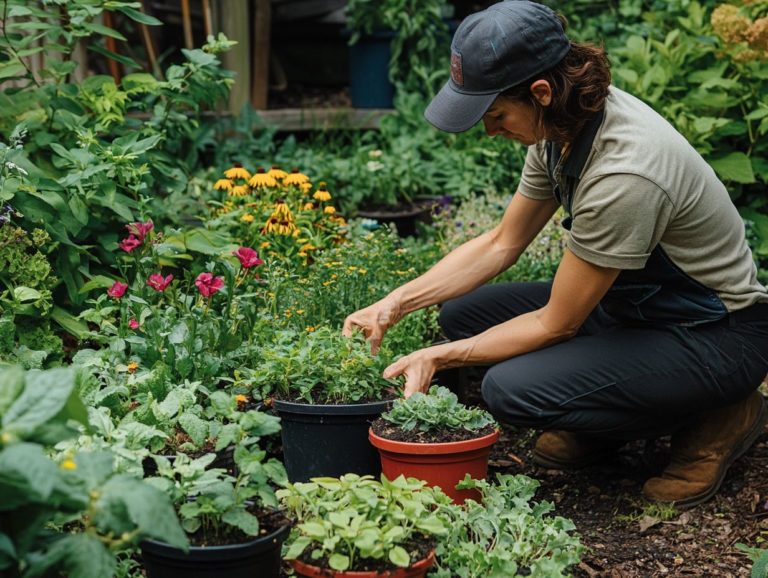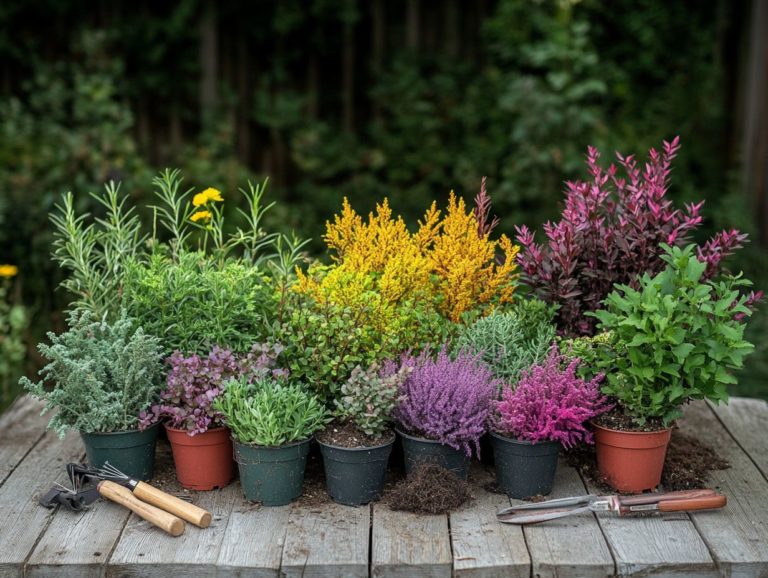Plants for Pollinators in Cold Climates
Pollinators are essential for sustaining plant life, particularly in cold regions where the harsh climate presents significant challenges.
This article delves into the vital contributions of pollinators in these frigid environments, highlighting both native and non-native plant species that attract these indispensable beings.
You ll uncover valuable tips for creating a pollinator-friendly garden, strategies for enticing specific pollinators like bees and butterflies, and effective methods to protect them during the winter months.
Embrace the opportunity to celebrate and support these crucial allies in our ecosystems!
Contents
Essential Insights for Supporting Pollinators:

- Pollinators are vital for plant survival in cold climates and adapt to changing conditions.
- Choose native plants to best support local pollinators.
- Create a pollinator-friendly garden by selecting diverse plants and offering shelter and food.
The Importance of Pollinators in Cold Climates
Pollinators are essential to the health of ecosystems, particularly in cold climates where environmental conditions can heavily influence plant life and biodiversity. In regions like British Columbia and places with harsh winters, the well-being of pollinators such as honeybees, solitary bees, and bumble bees is crucial for the survival of various plant species, including hardy annuals, perennials, shrubs, and trees. To support these pollinators, it’s important to know the best native plants for cold climates that provide essential food sources throughout the growing season.
Their work fosters blooming flowers and improves sustainable gardening practices, ultimately enriching the entire ecosystem and benefiting local wildlife as well as promoting organic gardening.
Why Pollinators are Essential for Plant Life
Pollinators are absolutely essential for plant life, acting as the key players in the transfer of pollen. This process enables the reproduction of a myriad of plant species, including the flowers, fruits, and vegetables that form crucial food sources for both humans and wildlife.
By fulfilling this vital role, bees especially honeybees and bumble bees not only enhance the production of various crops but also help sustain biodiversity (the variety of different plants and animals in an area) within ecosystems. Honeybees are renowned for their effective foraging strategies, diligently collecting nectar and pollen from a diverse range of plants, which boosts fruit and seed production. On the other hand, bumble bees excel at pollinating plants that require a special type of pollination that helps certain plants, like tomatoes, produce more fruit, leading to impressive yields.
The nectar serves as a primary energy source for these industrious insects, while the pollen offers essential proteins. This harmonious relationship ensures a thriving environment where both agriculture and natural habitats flourish.
Native Plants for Pollinators
Native plants lay the groundwork for exceptional gardening practices designed to attract and support pollinators. By incorporating these plants, you contribute to healthier ecosystems and enhanced biodiversity, all while enjoying the benefits of lower maintenance and reduced water requirements compared to non-native varieties.
Types of Native Plants that Attract Pollinators
Certain native plants, like borage, calendula, lilac, cherry, apple, and plum, can significantly attract a variety of pollinators. For those gardening in colder regions, selecting plants for cold climate community gardens can offer essential nectar and pollen to support their health and populations.
These plants bloom at different times throughout the growing season, ensuring a continuous food source for bees, butterflies, and other beneficial insects. For example, borage flowers from late spring to early fall. It thrives in well-drained soil and sunny spots, predominantly attracting honeybees with its abundant nectar.
Calendula, with its vibrant orange blooms, flourishes in cooler months. This makes it an invaluable resource for pollinators, especially when other food sources are scarce. Its flowering times make it particularly beneficial in early spring and late fall.
Lilacs beautify gardens with their delightful spring fragrance and attract various moths and butterflies. Meanwhile, fruit-bearing plants like cherry, apple, and plum bloom in early spring, fostering pollination activities that are crucial for fruit production. This also encourages a diverse ecosystem that allows insect populations to thrive.
Non-Native Plants for Pollinators

While native plants are essential for sustaining local ecosystems, some non-native plants also serve as valuable food sources for pollinators. This enhances biodiversity in various gardening contexts, creating a thriving environment that supports diverse life.
Non-Native Options for Pollinator Support
Non-native options, like certain varieties of herbs and flowering annuals, effectively provide nectar and pollen. This supports pollinator health across various gardening techniques.
Russian sage and lavender bring vibrant colors to your garden while attracting a delightful array of beneficial insects, including bees and butterflies. When incorporating these varieties, consider their specific light and soil requirements to create a nurturing environment.
Regular maintenance, such as deadheading and proper watering, is essential for keeping these plants thriving and maximizing their allure for pollinators.
Understanding these non-native species is key to a vibrant garden! You can cultivate a flourishing space that positively contributes to the ecosystem and supports the health of our essential pollinators. By integrating both native and non-native varieties, you can create a more resilient garden that withstands climate change.
Creating a Pollinator-Friendly Garden
Creating a pollinator-friendly garden requires a thoughtful blend of native and non-native plants. Diverse landscapes and effective gardening techniques are designed to meet the needs of various pollinators, such as bees, butterflies, and hummingbirds. Incorporating different plant varieties can enhance your garden’s appeal.
By selecting plants carefully and incorporating varied habitats, you can cultivate an inviting environment that supports these essential creatures.
Tips for Designing and Maintaining a Garden for Pollinators
To cultivate a vibrant, pollinator-friendly garden, begin by selecting flowers for a cold-climate border and a diverse array of plants that bloom at different times throughout the growing season. This ensures a continuous supply of food, keeping pollinators coming back for more.
This strategy enhances the garden’s visual charm and plays a pivotal role in meeting the diverse needs of bees, butterflies, and other beneficial insects. By considering the unique environmental conditions of your garden such as sunlight exposure and soil type pair plants that thrive in similar climates. This thoughtful approach simplifies maintenance and increases efficiency.
Opting for plants that require similar care fosters a harmonious ecosystem, ultimately reducing your overall workload. Creating habitats is also important; leaving patches of bare soil or incorporating nesting sites will significantly boost your garden s capability to attract and sustain pollinators throughout their life cycles.
Start planting today and watch your garden come alive with pollinators!
Attracting Specific Pollinators
Attracting specific pollinators like bees, butterflies, and hummingbirds demands a thoughtful strategy. This involves selecting the right plants and employing techniques that align with the preferences and behaviors of each species.
By carefully curating your garden, you create an inviting haven that supports these vital creatures and enriches your outdoor space.
Plants and Techniques for Attracting Bees, Butterflies, and Other Pollinators

Consider incorporating plants like lavender, milkweed, and salvia into your landscape. These plants are known to attract bees, butterflies, and hummingbirds. For a more tailored approach, check out selecting plants for cold-climate rain gardens. Additionally, provide water sources and shelter to help pollinators thrive.
To create an inviting environment for these essential creatures, add a variety of flowering plants that bloom at different times throughout the growing season. For example, bees have a fondness for the aromatic flowers of lavender. Colorful milkweed serves as a nectar source for butterflies and acts as a host for their caterpillars. Hummingbirds are especially drawn to vibrant blooms like salvia and bee balm, offering a quick energy boost.
Adding a shallow water dish and strategic ground cover can further improve habitat quality. Regularly deadheading spent flowers encourages more blooms. Ensuring your plants receive adequate sunlight and nutrients keeps them thriving and beneficial for pollinators throughout the year.
Protecting Pollinators in Cold Climates
Protecting pollinators in cold climates requires an active approach to manage their habitats effectively. By taking thoughtful measures, you can make a real difference in their survival through the harsh winter months. Consider incorporating plants for wildlife habitat in cold climates, which is crucial for maintaining both their populations and the overall health of the ecosystem.
Ways to Protect Pollinators from Harsh Winter Conditions
To protect pollinators from the harsh realities of winter, embrace a range of management practices designed to maintain their habitats and food sources during the colder months. For those interested in optimizing their gardens, selecting plants for shade in cold climates can provide essential nourishment and bolster the resilience of local ecosystems.
One effective strategy involves planting cover crops. These enrich the soil while offering cozy shelter for beneficial insects. Leaving behind dead plant matter in your garden creates natural insulation and habitat for overwintering pollinators, supporting their life cycles. Constructing bee hotels gives solitary bees a secure nesting place and significantly enhances their chances of survival.
By adopting these techniques, you can play a vital role in nurturing healthy pollinator populations, ultimately benefiting the entire ecosystem.
Frequently Asked Questions
- What are some good plants for pollinators in cold climates?
- Some great options for plants that attract pollinators in cold climates include bee balm, butterfly weed, aster, and goldenrod.
- Do these plants require any special care in colder temperatures?
These plants are hardy enough to survive cold temperatures but may benefit from a layer of mulch to protect their roots, especially during early spring or late fall.
- Are there specific plant species that work better for certain types of pollinators?
- Yes, different pollinators are attracted to different types of plants. For example, monarch butterflies are drawn to milkweed, while bees prefer flowers with flat, open blossoms.
- Can I still have a pollinator-friendly garden if I live in a colder climate?
- Absolutely! Many plants thrive in colder temperatures and attract pollinators. It’s all about choosing the right species for your climate and creating a hospitable environment for them.
Consider planting these flowers to create a pollinator-friendly space in your garden, along with low-maintenance plants for cold climates. Every little effort counts!
What elements should I consider for a pollinator garden in a cold climate?
Choose a variety of flowers that bloom at different times of the year.
Also, provide water sources and shelter for the pollinators.
Can I buy these plants locally or do I need to order online?
Support local businesses by checking your nearest garden center first.
If they don t have what you need, consider ordering from trusted online suppliers like Tonkadale Greenhouse or Oregon State University.

 These plants are hardy enough to survive cold temperatures but may benefit from a layer of mulch to protect their roots, especially during early spring or late fall.
These plants are hardy enough to survive cold temperatures but may benefit from a layer of mulch to protect their roots, especially during early spring or late fall.




